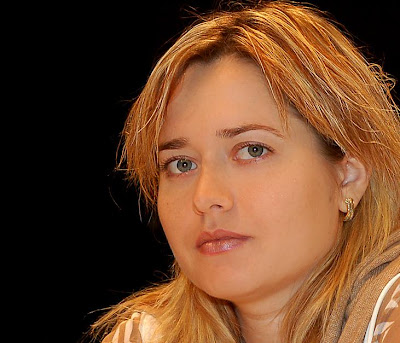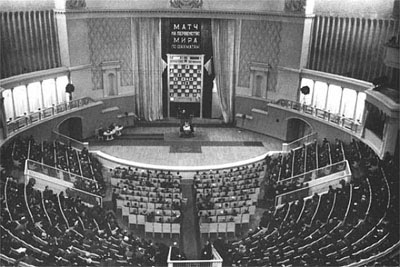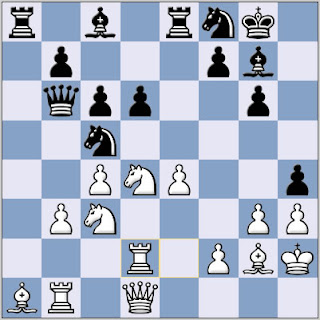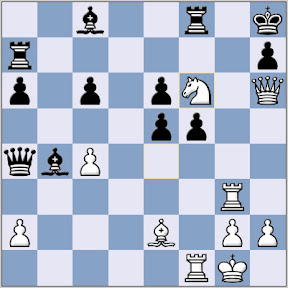The first, a Sandstone chess set, 'Nature Does Battle'

The second, the Auto part chess set, 'Rustic Warriors'

They are both available online from Novica.com








I like these moves (and also rate them as tough to find) not just because they offer a queen sacrifice, but they are also quiet: they don't make a capture and they don't make any obvious threat to win material. Black, however, has no defence:
Taking the Queen leads to mate:
1 Qh5!! Qxh5 2 Rxg7+ Kh8; 3 Rxf7+ Kg8; 4 Rg7+ Kh8; 5 Rg8 mate.
(taken from "Tactics in the Sicilian" by Gennady Nesis)
A number of you emailed in correct solutions: special mention to Chris Wardle, Andrew, Paul Dargan and Paul Runnacles.
Apologies for the slow posting of the solution, and the lack of material today on the blog: we had a powercut late yesterday evening that knocked my wireless router out of sync. Fortunately, everything is now back up and running.
"In the Sveshnikov (what we in England used to call the Pelikan) Black plays 4...Nf6 5.Nc3 and then 5...e5. The Kalashnikov (with 4...e5 and 5...d6) is the Sveshnikov's even brasher younger brother. Black has a horrible pawn structure but plenty of compensatory activity.
Radjabov gave up a pawn to mobilise his centre - as he would - and then when Anand initiated tactics with 21.f4 and 22.Rf2 played the queen sacrifice followed by the gorgeous 22...Nb5! regaining a piece since if eg 23.Bxb5 Bd4++ 24.Kg3 Bf2 mate or 24.Ke2 Rf2 mate.
Anand returned a further exchange to try to get control but the centre pawns rolled. If 33.Qxe4 Rc1+ 34.Kh2 Ne3 35.Qxh4 Black has at least perpetual check with Nf1+. Anand tried to race with his b pawn but came in second." GM Jonathan Speelman, The Independent 2003
Viswanathan Anand v Teimour Radjabov, Dortmund 2003
1.e4 c5; 2.Nf3 Nc6; 3.d4 cxd4; 4.Nxd4 e5; 5.Nb5 d6; 6.c4 Be7; 7.b3 f5; 8.exf5 Bxf5; 9.Bd3 e4; 10.Be2 a6; 11.N5c3 Bf6; 12.0-0 Nge7; 13.a3 0-0; 14.Ra2 Qa5; 15.b4 Qe5; 16.Re1 b5; 17.cxb5 axb5; 18.Bxb5 Nd4; 19.Bf1 d5; 20.Rd2 Be6; 21.f4 Qxf4; 22.Rf2

23...Qxf2+; 23.Kxf2 Nb5; 24.Kg1 Nxc3; 25.Nxc3 Bxc3; 26.Bb5 Bxe1; 27.Qxe1 Nf5; 28.Bb2 Rac8; 29.Ba4 Rf7; 30.h3 h5; 31.b5 h4; 32.Be5 d4; 33.b6 e3; 34.Kh2 d3; 35.Qb4 e2; 36.Bc3 Rxc3; 37.Qxc3 Ng3; 38.b7 Rxb7; 39.Qa5 Rb8 0- 1






 Staunton's "The Laws and Practice of Chess" (see eBay listing) is split into three 'books': the first deals with the laws and a guide to playing the game, and the second two books to 19th Century opening theory.
Staunton's "The Laws and Practice of Chess" (see eBay listing) is split into three 'books': the first deals with the laws and a guide to playing the game, and the second two books to 19th Century opening theory.
"chess player against the elements"
I can still imagine the dream vividly: kayaking through chilly northern seas, across some remote sea loch, scaling the great mountains via a towering ridge, making a bivouac for the night, and then well fed on bacon butties (from a slaughtered wild pig of course) strolling into town to play swashbuckling chess.
It was with this 'nirvana' in mind that we drove up to Hawick on a Friday afternoon in early summer, pitched our tents between a couple of caravans on a campsite with full facilities, and armed with just ultra-lite portable stoves prepared to face the worst that nature could throw at us.
The chess started well with a win on the Friday night, but Saturday and Sunday were horrors. No sleep (roll-out mat useless), nowhere to get food (the only restaurant we could find was full), poor decision by the arbiter (he told me later he was wrong), and to cap it all no points that I can remember.
This year I won't be camping!
The tournament itself is quite strong for a 'remote' weekend swiss event. I played Steve Mannion, an International Master in round 2 on my visit, and I notice that despite last year's Open field having only 14 competitors, it included a Grandmaster (Colin McNab), 2 International Masters, and a FIDE Master.
As for Hawick, it's one of a string of towns in the Scottish Borders (rolling hills along the border with England) that grew up around the wool & textile trade. It has some impressive buildings, including the Town Hall which is the congress venue, but does have a bit of a forgotten feel.
If I can find accomodation with an Internet connection, I'll keep you updated during the tournament.
 I began my training régime today for the British Chess Championships, and if I'm honest, to do something about a 'lifestyle' physique that's starting to say "chess and blogging". I'll be doing some mental preparation as well, but the physical will be perhaps more important, especially as an underdog in what will be a gruelling 11-round event.
I began my training régime today for the British Chess Championships, and if I'm honest, to do something about a 'lifestyle' physique that's starting to say "chess and blogging". I'll be doing some mental preparation as well, but the physical will be perhaps more important, especially as an underdog in what will be a gruelling 11-round event."Kasparov showed to the world the importance of physical fitness to chess players. His training regimen included swimming, playing football and cycling. Truly, his high energy level kept him going." Hinduonnet
There are about 6 weeks until the tournament begins, I'm reckoning that's about 18 runs and a lot of sit-ups and press-ups. I can feel the lung capacity coming back already!
I once thought about Pilates as well and bought a book by Brooke Siler (she's famous for getting a number of Hollywood stars looking sleek), but so much is about correct technique and control that I think it would only really work with a good trainer alongside. So Brooke, if you fancy learning chess in exchange, give me a shout and I'm sure we'll be able to work something out.







I was playing chess in the afternoon with my friend Roger, our top blogger. We even had a nice Czech beer to help the brains work better. Roger's a big fan of the King's indian so by game 3 I played d4 and we were on his battleground. I played g3 and advanced the centre pawns. Roger then announced that he had seen it all before or similar, it was an excellent practice game, first he dominated on the Queenside and then I hit back with a pawn sac. He played really well and I lost. Roger identified the game which was similar, it was Botvinnik vs Tal, once he mentioned it I remembered it too. When I got home I looked at my books, he was right, but of course Tal played it better than Rog! Botvinnik placed his queen on d3 instead of e2 but later it went back. I checked my theory book and it wasn't there- that's seriously out of fashion. I suppose it's not smart to tread a pathway where a world champion got murdered.
I think the King's indian is starting to fade as one of the top openings. I play it myself as black and its because I wanted to follow Fischer and Kasparov, not that I have any chance of playing like them but it's rather that their play has sprinkled magic dust on the board and one battlefield you remember is the King's Indian. Copy some of the moves and its like your recalling the action, remember when you're ten and its football and you are the players, we used to pick them, my friend was Pele and I was Alan Ball and when we scored we'd shout PELEEE!The openings too complicated for me but who cares. It gives a disadvantage for black, that's okay we all play for fun don't we.
Getting back to my opening remark. None of the top players seem to play it and now Garry has left the world game maybe the young will grow up on slav defences and different Sicilians to the Najdorf. When Kramnik killed Garry Kasparov in the King's Indian could that have been the end of a chapter for the opening?
Then I checked back on famous moments in the opening:
Tal - Fischer, Bobby took a Tal pawn and asked him to prove it, well he did and its one of the best games ever.
Piket- Kasparov with Garry sacking on g3 with the black knight.
Okay its an addiction, maybe I'll leave the Slav alone for another year!
Martin

Lest any of you should be worried that recent articles featuring Anna Matnadze and Almira Skripchenko show Chess Tales adopting a certain sexual bias, let me quickly balance the coverage by showing this photo of two fine young men:
The photo is scanned from the February 1989 edition of Schach Report, and shows them at the European Junior Chess Championships where they tied for first place. They both went on to become Super Grandmasters and compete in the candidates matches. Can you name them?
The first rule of chess club is... nobody talks about chess club








Find a sponsor for your web site. Get paid for your great content. shareasale.com.
